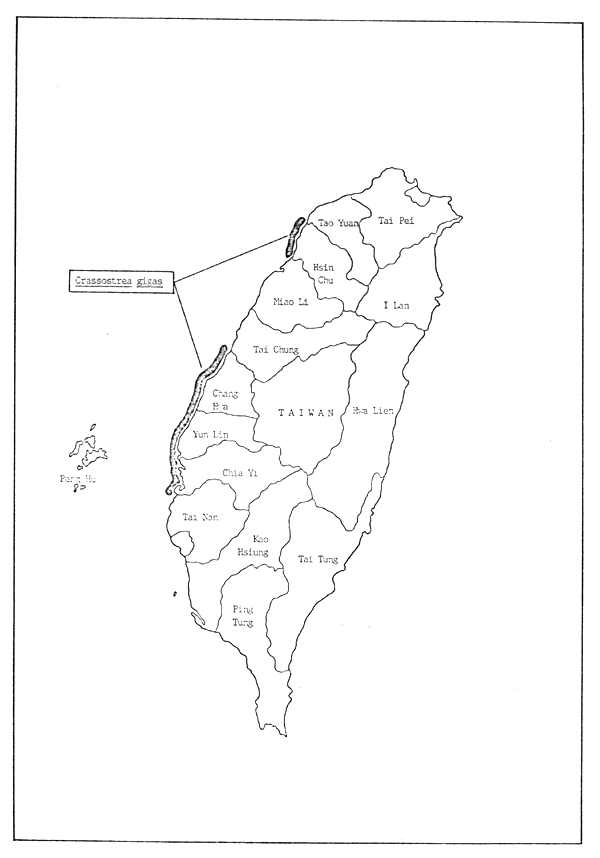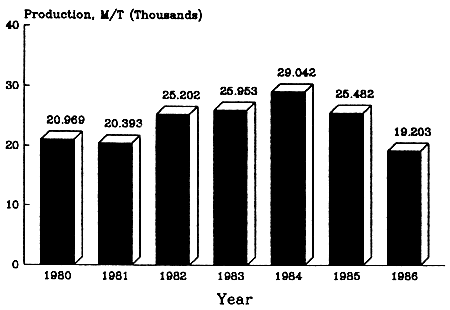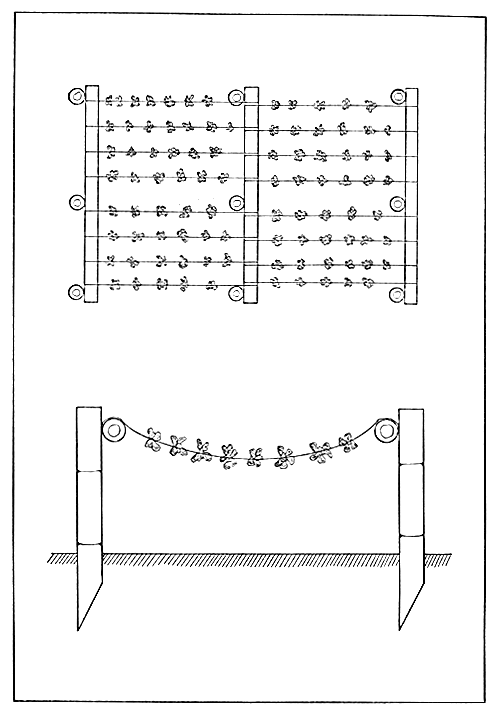Culture of the Pacific oyster Crassostrea gigas is the most
important shellfish culture in Taiwan (Ting, 1984). Farming
areas are found all over the west coast of the island from the
northern tip of Tai Pei to the southern part of Ping Tung
prefecture. However, most of the production derives mainly from
the Hsin-Chu, Chang-Hwe, Yun-Lin and Chia-Yi areas due to
favourable environmental conditions. Production from these four
prefectures accounted for over 90% of the total oyster production
in Taiwan in 1980 (Table 10 and Fig. 21).
Oyster production figures in Taiwan from 1980 to 1986 are shown
in Figure 22. Among the important species of bivalves cultured
in Taiwan (which include the hard clam, Meretrix lusoria; short-necked
clam, Gomphina veneriformis; and purple clam, Soletellina
diphos) the Pacific oyster is the one with the highest annual
production. The total output in 1986 of oysters, hard clams,
short-necked clams, blood cockle and purple clams was 37,261 MT
of which 19,203 MT (48 %) were from C. gigas. Except for the
relatively low production in 1986 (19,203 MT), production during
the last two decades has increased steadily from 8,866 MT in 1965
to 25, 482 MT in 1985.
The area under oyster culture in 1980 was 11,205 hectares which
accounted for 62.75 % of the total shallow sea area devoted to
shellfish culture in Taiwan.
Both culture and fishing from natural grounds is practised by local fishermen. Oyster seed are collected by luring settling larvae. Although spats abound all year round spat collection is practised in two set periods (November - February and July -August) to prevent siltation and fouling of the spat collectors. Cultches are made of 100 to 150 left oyster shells suspended from a nylon rope, or a string of 10 to 15 left shells set roughly 20 cm apart. The former ones are fixed horizontally onto the rafts while the latter lures are suspended in groups of 5 to 10 vertically from the raft. However, where the water depth is less than 1 m bamboo sticks are often used as cultch on which the oyster grow to marketable size. Spatfall during the collecting seasons may be considerable and as many as 200 spats may settle on one oyster shell. However, it is reported that the desirable density, in order to promote good and uniform growth, is 30 spat per shell (Chen, 1976). Thinning of the oyster collectors is practised when necessary. The spats will usually grow to a size of 6 to 7 mm in 2 months after settling and become suitable for transferring to the on-growing areas.
Five methods of oyster culture are practised in Taiwan, depending on the on-growing site.
Bamboo stick method. This method has been practised for the longest period by the island fishermen, mainly due to the low initial capital cost and simplicity. The oysters are fixed onto a bamboo pole which is then driven into the bottom of shallow coastal areas as well as along the banks of estuaries. The bamboo sticks are planted in rows. The space between rows is 40 to 60 cm and that between sticks is 20 to 30 cm, varying with localities. Passages 2 to 3 m wide are provided at suitable places to allow the entrance of bamboo rafts or other small craft for transporting cultch material and harvested oysters.
Hanging method. This method is practised in deeper waters. The culture supporting framework is made of bamboo and usually covers a surface area of 180 to 240 m2. In some localities they may cover an area as large as 600 m2. From the supporting framework, oyster culture ropes are suspended at a density of 10 to 15 strings per m2 depending on the productivity of the area. The length of each string varies between 1 to 3 m depending on the depth of the water column.
Suspending method. This method is practised in shallow seawater areas not suitable to the hanging method. The supporting bamboo framework consists exclusively of a series of parallel bamboo poles fixed on top of a series of bamboo poles previously driven into the soft bottom. The vertical poles usually measure 100 to 120 cm in height once fixed to the substratum, while the horizontal poles are placed roughly 150 to 250 cm apart. The total length of the described structure varies between 20 to 40 m. The culture strings, each with 8 to 12 parental shells, are tightened horizontally between the parallel bamboo poles (Fig. 23).
Long-line method. In this method, two long parallel lines of styrofoam floats, spaced 6–8 m apart, connected to one another with rope, are placed in the selected culture areas. The ends of the lines are anchored to the bottom. Culture strings each with 15 to 20 oyster shells are suspended 40–60 cm apart from the nylon rope stretched between each parallel pair of floats.
Raft method. The rafts are made up of bamboo poles and commonly measure 15 × 7.5 m. They are usually buoyed by empty oil drums or styrofoam cylinders and laid out in lines 1 to 3 m apart and anchored to the bottom at both ends. Nylon strings with oyster shell strung 15 to 20 cm apart are suspended 40 to 50 cm apart from the raft. Although little care is required during the growth of the oysters, the farmers need to inspect the rafts to check for any damage and to remove those oysters that have reached marketable size. Thinning of the strings becomes necessary especially towards the end of the growing season and during the productive periods of the sea due to fouling.
No particular problem is inhibiting oyster culture in Taiwan at present. However the limited supply of seedlings from the wild forms the bottle-neck of shellfish production in the country. Other constraints which need to be dealt with are overfishing and water pollution.
For its oyster industry to expand in the near future, Taiwan must now increase the culture area especially in coastal areas and protect natural resources in order to ensure a reliable supply of seed. In addition, artificial propagation techniques as well as water pollution control measurements are two major topics which are receiving considerable attention.
| SPECIES | PREFECTURE | LOCALITY | NOTES |
| Crassostrea qiqas | Tai Pei | -- | Natural fisheries and culture grounds. |
| Tao Yuan | -- | Natural fisheries and culture grounds. | |
| Hsin Chu | -- | Natural fisheries and important culture grounds. | |
| Miao Li | -- | Natural fisheries and culture grounds. | |
| Tai Chung | -- | Natural fisheries and culture grounds. | |
| Chang Hwa | -- | Natural fisheries and important culture grounds. | |
| Yun Lin | -- | Natural fisheries and important culture grounds. | |
| Chia Yi | -- | Natural fisheries and important culture grounds. | |
| Tai Nan | -- | Natural fisheries and culture grounds. | |
| Kao Hsiung | -- | Natural fisheries and culture grounds. | |
| Ping Tung | -- | Natural fisheries and culture grounds. |

Figure 21: Main oyster culture areas in Taiwan.

Figure 22: Oyster production data in Taiwan from 1980 tô 1986. (Source: Ting, Y.Y., Pers. comm., 1988).

Figure 23: Suspending oyster culture method as practised in Taiwan.